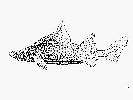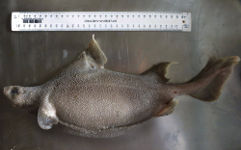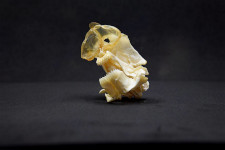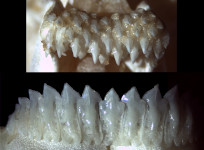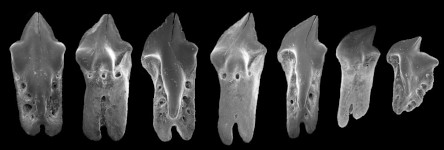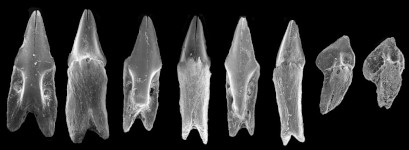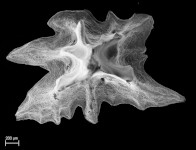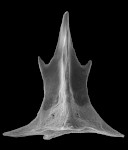Oxynotus bruniensis
(Ogilby, 1893)
Prickly dogfish
Classification: Elasmobranchii Squaliformes Oxynotidae
Reference of the original description
Description of a new shark from the Tasmanian coast. Records of the Australian Museum, 2(5), 62–63
Description of a new shark from the Tasmanian coast. Records of the Australian Museum, 2(5), 62–63
Image of the original description
No image in first description.
No image in first description.
Synonyms / new combinations and misspellings
Centrina bruniensis
Centrina bruniensis
Description :
Citation: Oxynotus bruniensis (Ogilby, 1893): In: Database of modern sharks, rays and chimaeras, www.shark-references.com, World Wide Web electronic publication, Version 12/2025
Please send your images of "Oxynotus bruniensis" to info@shark-references.com
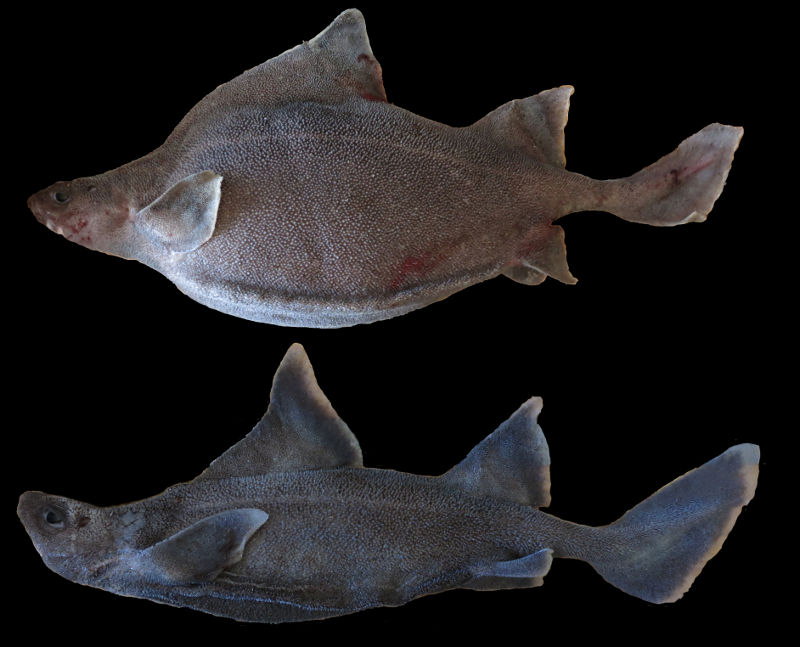
Oxynotus bruniensis (Ogilby, 1893), mature female (up) and maturing male © Brit Finucci

Oxynotus bruniensis (Ogilby, 1893), mature female (up) and maturing male © Brit Finucci
Common names
 Cerdo marino agujeta,
Cerdo marino agujeta,  Centrine aiguille,
Centrine aiguille,  Pepeke,
Pepeke,  Prickley dogfish,
Prickley dogfish,  Prickly dogfish,
Prickly dogfish,  Rough shark
Rough shark
 Cerdo marino agujeta,
Cerdo marino agujeta,  Centrine aiguille,
Centrine aiguille,  Pepeke,
Pepeke,  Prickley dogfish,
Prickley dogfish,  Prickly dogfish,
Prickly dogfish,  Rough shark
Rough shark
Short Description
Spiracle small and circular. Supraorbital ridges not greatly expanded and not forming a knob in front of spiracles. Pectoral fins leaf–shaped, not strongly falcate. Predorsal spine length from snout to first dorsal–fin spine 2.0 to 2.3 in precaudal length. Apices of dorsal fins broadly triangular, posterior margins straight or weakly concave. First dorsal– fin spine inclined forwards. First dorsal–fin anterior margin from spine to apex 1.0 to 1.8 in first dorsal spine height, second dorsal–fin anterior margin from spine to apex 1.0 to 1.3 in second dorsal–fin spine height. Second dorsal–fin base 0.7 to 1.1 in interdorsal space, second dorsal–fin origin well anterior to pelvic–fin origins. Vertebral counts: total vertebral counts 84 to 94, total precaudal vertebral counts 58 to 64. Intestinal valve turn counts 10 to 11. Colour: uniform grey–brown, without prominent markings. [19900].
Spiracle small and circular. Supraorbital ridges not greatly expanded and not forming a knob in front of spiracles. Pectoral fins leaf–shaped, not strongly falcate. Predorsal spine length from snout to first dorsal–fin spine 2.0 to 2.3 in precaudal length. Apices of dorsal fins broadly triangular, posterior margins straight or weakly concave. First dorsal– fin spine inclined forwards. First dorsal–fin anterior margin from spine to apex 1.0 to 1.8 in first dorsal spine height, second dorsal–fin anterior margin from spine to apex 1.0 to 1.3 in second dorsal–fin spine height. Second dorsal–fin base 0.7 to 1.1 in interdorsal space, second dorsal–fin origin well anterior to pelvic–fin origins. Vertebral counts: total vertebral counts 84 to 94, total precaudal vertebral counts 58 to 64. Intestinal valve turn counts 10 to 11. Colour: uniform grey–brown, without prominent markings. [19900].
Distribution
Southwest Pacific: confined to temperate waters off southern Australia and New Zealand. Source: www.gbif.org
Southwest Pacific: confined to temperate waters off southern Australia and New Zealand. Source: www.gbif.org
Human uses
fisheries: of no interest
fisheries: of no interest
Biology
Yolk–sac viviparous, with a litter of 7 embryos reported for one female. [19900]. Size at birth about 24 cm [1388]. Distinct pairing with embrace [17086]. Found on outer continental and insular shelves and uppermost slopes. O. bruniensis preys exclusively on the egg capsules of holocephalans [24413].
Yolk–sac viviparous, with a litter of 7 embryos reported for one female. [19900]. Size at birth about 24 cm [1388]. Distinct pairing with embrace [17086]. Found on outer continental and insular shelves and uppermost slopes. O. bruniensis preys exclusively on the egg capsules of holocephalans [24413].
Size / Weight / Age
Maximum total length about 75 cm, possibly 91 cm; adult males mature at about 60 cm, adult females to 72 cm. Size at birth is about 24 cm. [19900]; gravid females (65.0, 67.5 and 71.2 cm LT) were observed, all with eight embryos. Size-at-birth was estimated to be 25–27 cm LT [24413].
Maximum total length about 75 cm, possibly 91 cm; adult males mature at about 60 cm, adult females to 72 cm. Size at birth is about 24 cm. [19900]; gravid females (65.0, 67.5 and 71.2 cm LT) were observed, all with eight embryos. Size-at-birth was estimated to be 25–27 cm LT [24413].
Dentition
Teeth on upper and lower jaws dissimilar; uppers lanceolate, narrowly erect, central rows awl–shaped, posterior rows broadly triangular and blade–like; cusp smooth–edged with no lateral cusplets or blades, in quincunx formation in a narrow triangular pad, not imbricated; lower teeth imbricated, erect, with a distally oblique broad, sharp–edged, serrated cusp, and no lateral cusplets; tooth row counts upper jaw 12 to 19, lower jaw 11 to 13. [19900].
Teeth on upper and lower jaws dissimilar; uppers lanceolate, narrowly erect, central rows awl–shaped, posterior rows broadly triangular and blade–like; cusp smooth–edged with no lateral cusplets or blades, in quincunx formation in a narrow triangular pad, not imbricated; lower teeth imbricated, erect, with a distally oblique broad, sharp–edged, serrated cusp, and no lateral cusplets; tooth row counts upper jaw 12 to 19, lower jaw 11 to 13. [19900].
Remarks
shark-references Species-ID=4476;
shark-references Species-ID=4476;
Parasites (arranged by Jürgen Pollerspöck)
Monogenea
Monogenea
- Asthenocotyle taranakiensis Beverley-Burton, Klassen & Lester, 1987 [11676]








